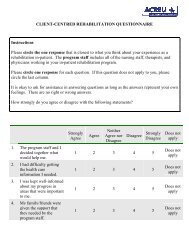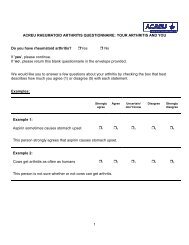Client-Centred Rehabilitation - Arthritis Community Research ...
Client-Centred Rehabilitation - Arthritis Community Research ...
Client-Centred Rehabilitation - Arthritis Community Research ...
You also want an ePaper? Increase the reach of your titles
YUMPU automatically turns print PDFs into web optimized ePapers that Google loves.
48<br />
In summary, there is no single measure of<br />
the extent to which a particular rehabilitation<br />
program is client-centred. Instead, a<br />
multifaceted approach is required that<br />
incorporates a number of indicators at the<br />
level of the client/ professional and the<br />
system. Many of the client level indicators<br />
from the client’s perspective are tapped by<br />
the WASCANA, however this measure in<br />
and of itself does not capture the extent to<br />
which a particular program is client-centred.<br />
In addition, evidence as to the presence of<br />
other components of client-centred care is<br />
needed.<br />
4.3 Implications for the<br />
<strong>Rehabilitation</strong> Reference Group<br />
Framework<br />
Our findings provide support for many of<br />
the directions put forward in “Managing the<br />
Seams: Making the <strong>Rehabilitation</strong> System<br />
Work for People” (Provincial <strong>Rehabilitation</strong><br />
Reference Group, MOHLTC, 2000).<br />
1) “<strong>Rehabilitation</strong> services must aim to meet<br />
the needs of individuals at the three levels of<br />
client need (impairment, activity limitation<br />
and participation).” [p. 22, Provincial<br />
<strong>Rehabilitation</strong> Reference Group, MOHLTC,<br />
2000]. Our findings suggest that<br />
rehabilitation services mainly address two<br />
levels of client need (impairment and<br />
activity limitation) but that the participation<br />
level of client need is not being addressed<br />
adequately. Steps must be taken to ensure<br />
that rehabilitation services better prepare<br />
clients for community living. This will<br />
require:<br />
♦ education of rehabilitation<br />
professionals with respect to<br />
participation level interventions<br />
♦ training of physicians and allied<br />
health care providers with respect to<br />
the meaning and practice of clientcentred<br />
care – both at the<br />
undergraduate level and for<br />
practicing clinicians<br />
♦ linkages between various<br />
components of the system (e.g.<br />
hospital based rehab services and<br />
community based service providers).<br />
♦ research to identify best practices<br />
with respect to participation level<br />
interventions.<br />
♦ increased public awareness of<br />
community programming to meet<br />
ongoing client needs for community<br />
involvement<br />
2) “For many years, services partners such<br />
as the Canadian Paraplegic Association, The<br />
<strong>Arthritis</strong> Society, and the Heart and Stroke<br />
Foundation have played pivotal roles within<br />
the rehabilitation system (providing peer<br />
support and counseling, volunteer led<br />
programs, information and service<br />
coordination) but their roles have not been<br />
recognized as being integral to the larger<br />
system” (p. 22, Provincial <strong>Rehabilitation</strong><br />
Reference Group, MOHLTC, 2000). Our<br />
findings strongly support this point.<br />
♦ The role of community service<br />
providers and disease specific<br />
organizations needs to be recognized<br />
and augmented and linkages to<br />
formal rehabilitation programs<br />
enhanced.<br />
♦ There is a need for programs and<br />
services that provide on-going<br />
emotional support for clients. These<br />
do not necessarily need to be<br />
professional-driven but could be<br />
provided through support groups,<br />
peers, and mentoring. The <strong>Arthritis</strong><br />
Society and its client services








